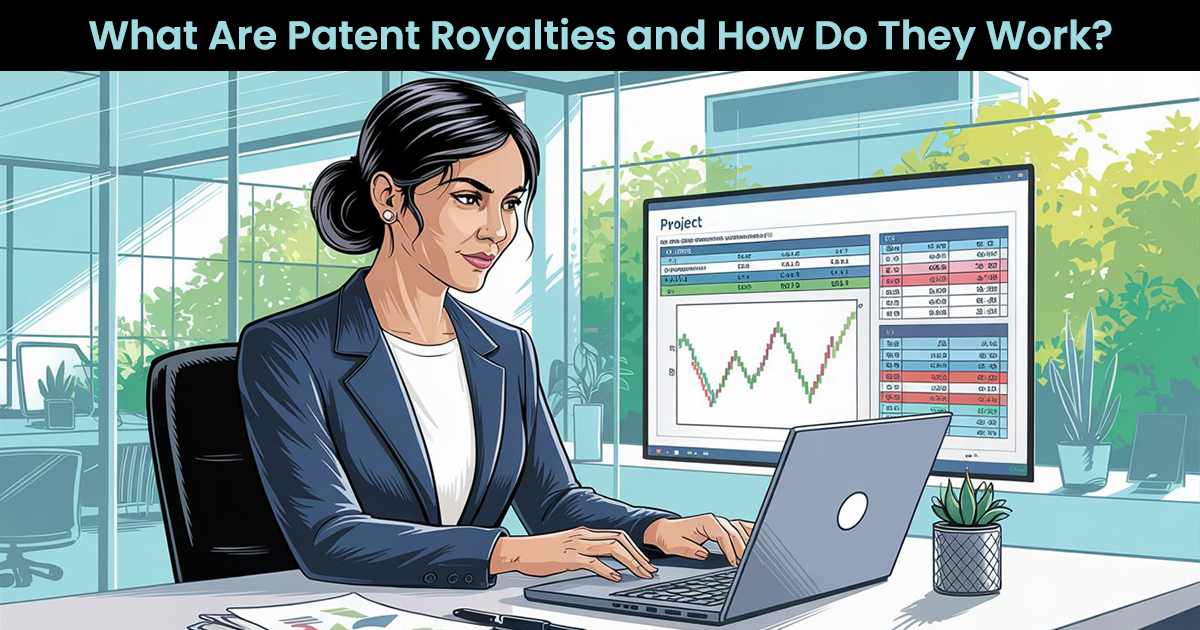No Results Found
The page you requested could not be found. Try refining your search, or use the navigation above to locate the post.
The page you requested could not be found. Try refining your search, or use the navigation above to locate the post.
For finance professionals working in biotech, understanding how patent royalties work is essential for managing budgets, structuring agreements, ensuring compliance, and supporting strategic business decisions.
This article explores the fundamentals of patent royalties, how they are calculated, types of royalties, what affects royalty rates, the structure of royalty agreements, and how financial reporting is typically handled.
Complex calculations become streamlined when Royalty Tracker® automates patent royalties with precise tracking for patent licensing royalty agreements.

Patent royalties are payments made by a licensee (the party using the patented technology) to a licensor (the patent owner) in exchange for the legal right to use, produce, sell, or commercialize an invention covered by a patent. These royalties serve as compensation to the patent holder for the use of their intellectual property.
In the biotech licensing agreements, patent royalties commonly involve licensing molecules, drug delivery systems, genetic modifications, or other proprietary innovations. These royalties provide a revenue stream for the patent owner and access to critical technologies for the licensee.
When a company holds a patent and another company wants to use that technology, they enter into a licensing agreement. This agreement grants specific rights to the licensee while requiring them to make royalty payments based on agreed-upon terms.
The royalty payments can be structured in different ways, including:
Licensees often report sales and usage data to licensors on a quarterly or annual basis, and royalty payments are calculated based on this reporting.
The method for calculating royalties depends on the agreement structure and the type of royalties. The most common method in biotech is a percentage-based running royalty. Here’s a simplified example:
Let’s say a biotech company licenses a patented delivery method for a new drug. The royalty agreement specifies a 5% royalty rate on net sales. If the product earns $10 million in net sales for the quarter, the royalty payment would be:
{Royalty} = {Net Sales} X {Royalty Rate} = $10,000,000 X 0.05 = $500,000
Other factors that may play into the calculation include:
In milestone-based models, payments may be set at fixed amounts based on events (e.g., $2 million upon regulatory approval).

Consider a theoretical example of a patent royalty situation:
A university research center develops a novel therapeutic compound and patents it. A biotech company, seeing potential in the compound, enters into a licensing agreement to develop it into a marketable drug.
The agreement includes:
Over time, the biotech company markets the drug successfully, generating $50 million in annual net sales. Their royalty payment each year would be $2 million (4% of $50 million), in addition to any milestone payments and minimums in the earlier years.
Realistically, a patent royalty agreement will include additional terms that add complexity to these calculations, as described above in the “How Do You Calculate Patent Royalties?” section.
Tiered rates, kit splits, deductions, caps, floors – our system handles these complex patent royalties calculations instantly while you focus on strategy. Eliminate calculation errors and compliance risks. Get your free consultation now.
A patent royalty agreement is a legal contract between the licensor and licensee that outlines the terms under which the licensee can use the patent and how royalties will be paid. It defines rights, responsibilities, payment structures, and compliance requirements.
These agreements are highly negotiated and tailored to the needs of both parties. They must account for legal protections, financial terms, operational roles, and contingencies such as patent invalidation or disputes.
While the content varies, most agreements include the following core elements:
Many factors influence royalty rates in a patent licensing deal:

Licensees gain several strategic advantages when paying for patents through a royalty-based model:
For finance professionals, the key is to model the long-term return on investment of the royalty obligations versus the benefits gained.
In the biotech industry, reporting and compliance requirements for patent royalties are governed by a mix of contractual obligations, intellectual property law, tax regulations, and industry-specific standards.
Legal and tax requirements around reporting and compliance can be complex and variable, so be sure to consult with legal and accounting specialists regarding your specific business. The following are some of the most common contractual and internal reporting requirements.
Most patent licensing agreements will include requirements for regular reporting of royalty earnings to the licensor. Contracts may stipulate:
You will likely also need access to these internal financial reports, among others, for accounting and planning purposes:
Royalty automation software like MetaComet®’s Royalty Tracker® can streamline all the processes above to enable accurate royalty calculations with the click of a button. No matter how complex your contract terms or product variables, Royalty Tracker® is quick and easy, secure and reliable.
Would you like to see how MetaComet® can eliminate the stress and errors from your royalty calculations, payments, and reporting? Contact us to schedule an informational meeting or demo today. We can have your Royalty Tracker up and running smoothly within 3 months.

David Marlin is the President and Co-Founder of MetaComet® Systems, a prominent provider of royalty automation tools. Since founding the company in 2000, David has spearheaded the development of a suite of best-in-class systems that effectively facilitate royalty processes for nearly 200 publishers. David has also served as the chair for The Book Industry Study Group’s Rights Committee and Digital Sales Committee.
Before establishing MetaComet Systems, David served as a technology consultant for renowned publishers, collaborating with notable companies such as Random House, Penguin, HarperCollins, Holtzbrinck, Macmillan, Scholastic, Time Warner, and many others. David holds both an MBA and a BA from Columbia University in New York.
"*" indicates required fields